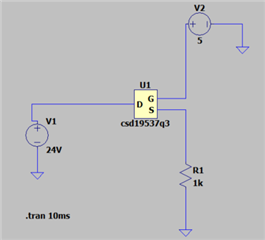Other Parts Discussed in Thread: TINA-TI
Tool/software:
Hi E2E Elites,
I'm currently using the spice model downloaded from TI website and created a symbol inside LTSpice. 
Based on the datasheet it says, Vgs needed typical 3V so that my 24V able to drop on my R1.
Below is my simulation result:
The results shown at source side is only 2V instead of 24V.
Am I miss out anything?
Thanks.
Regards,
JS

